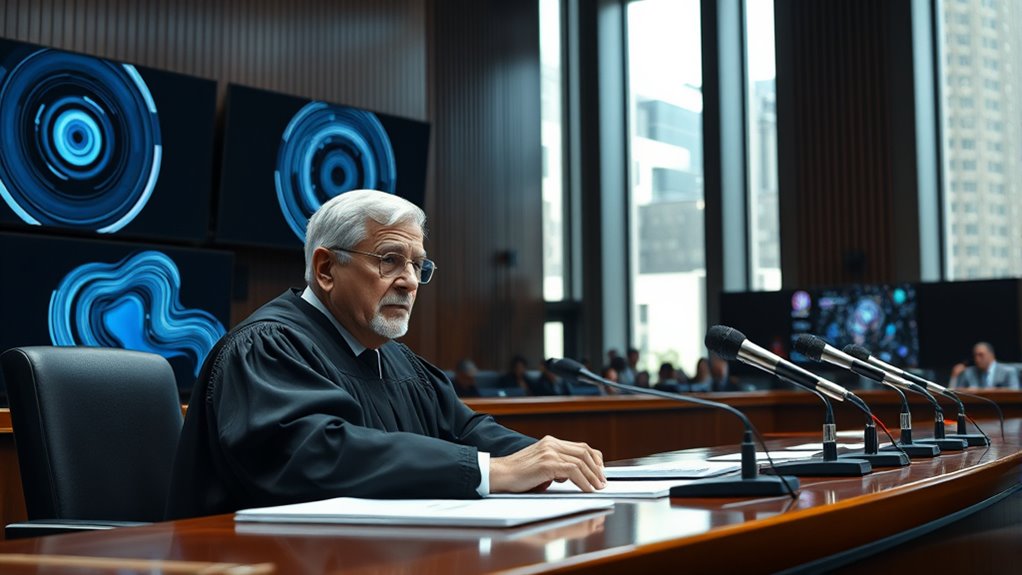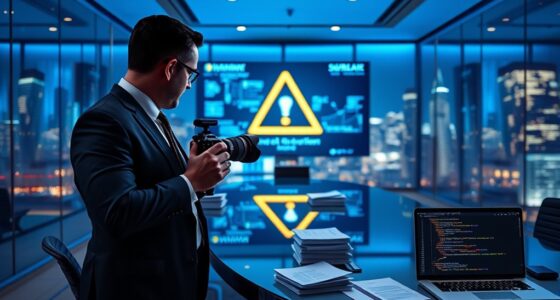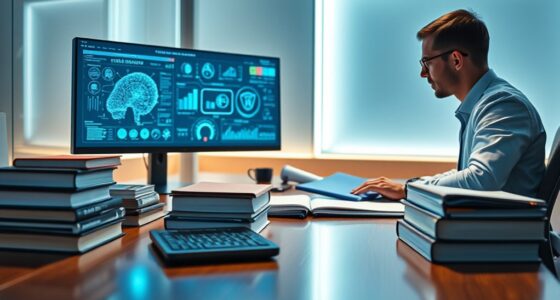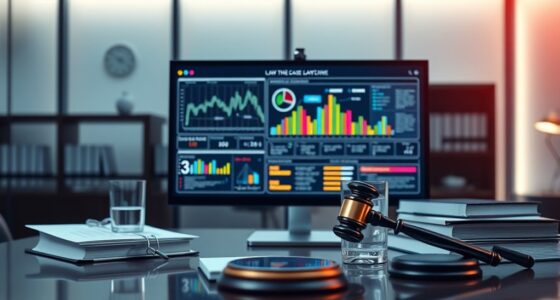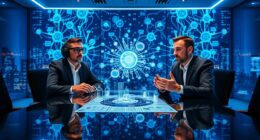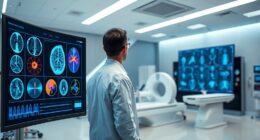A recent court ruling confirms that AI-generated art can’t be copyrighted because current laws require a human author. This means if you’re using AI to create art, you likely can’t claim exclusive rights unless you involve significant human input. The decision sets a legal precedent that emphasizes human involvement as necessary for protection under copyright laws. If you want to understand how this ruling could affect artists and developers, there’s more to explore.
Key Takeaways
- The court ruled that AI-generated art lacks human authorship, which is required for copyright protection.
- This decision establishes a legal precedent that AI-created works cannot be copyrighted under current law.
- The ruling emphasizes that human involvement is necessary to qualify for copyright claims.
- AI works are considered public domain unless significant human contribution exists.
- The case highlights the need for legal updates to address evolving AI and creative technologies.

A recent court ruling clarifies that AI-generated art cannot be protected by copyright. This decision sends a clear message about the legal implications surrounding artificial intelligence creations and raises important questions about intellectual property rights. You might wonder how this impacts artists, developers, and consumers alike. The ruling emphasizes that, under current law, copyright protection requires a human author’s direct involvement, and AI, as a tool or autonomous creator, doesn’t meet that threshold. This means that even if you use AI to generate art, you may not be able to claim exclusive rights over it. The legal implications are significant because they challenge how we view creativity and ownership in an increasingly digital world. As AI technology advances, lawmakers will need to reconsider existing copyright laws to address these new forms of creation. Until then, this ruling sets a precedent that AI-generated works are in the public domain unless a human has made substantial creative contributions.
This decision also stirs ethical considerations. If AI can produce art that rivals human creations, should it be protected under copyright law? Or does granting rights to AI-generated works diminish the value of human artistry? You might feel that this creates a gray area, where the line between human and machine creativity blurs. Some argue that giving AI works copyright protection could lead to monopolization and stifle innovation, while others believe it could incentivize developers to create more advanced AI technologies. The court’s stance underscores the importance of human involvement and creativity as essential components of copyright eligibility. Additionally, the debate over intellectual property rights continues to evolve in response to technological advances. As a creator or user of AI art, you should consider the ethical implications of your work—whether you’re leveraging AI as a tool or relying on it as the sole creator. This ruling encourages a discussion about fairness, ownership, and the responsibility that comes with deploying AI in creative fields.
Ultimately, the ruling reflects the current legal framework but also highlights where it might need evolution. For now, the focus remains on human-driven creativity, but the landscape is rapidly changing. You need to stay informed about these developments because they could affect how you protect your own creations or navigate intellectual property rights in the future. The intersection of law and ethics in AI-generated art remains complex, and this case serves as a reminder that the law is still catching up with technological progress. As AI continues to grow, expect these debates to intensify, prompting lawmakers, creators, and society to rethink what originality and ownership truly mean in the digital age.
Frequently Asked Questions
How Does This Ruling Impact Existing Ai-Generated Artworks?
This ruling impacts your existing AI-generated artworks by establishing a legal precedent that they can’t be protected under copyright. You might find it harder to assert intellectual property rights over these creations, meaning your work could be more vulnerable to unauthorized use. It emphasizes that, without human authorship, AI art doesn’t qualify for copyright, so your ability to control and monetize your AI-generated pieces could be markedly limited moving forward.
Can Artists Still Claim Rights Over Ai-Assisted Creations?
You can still claim rights over AI-assisted creations, but remember, “every cloud has a silver lining.” The court’s decision emphasizes authorship attribution and moral rights, meaning your contribution matters. You may not hold copyright if the AI does most of the work, but your creative input and intent still deserve recognition. Stay vigilant with your rights, and guarantee your role in the process is clear to protect your moral rights.
Will This Decision Influence International Copyright Laws?
This decision will likely influence international implications by prompting countries to reconsider how they handle AI-generated art. You might see efforts toward legal harmonization as nations aim to create consistent copyright standards. While some countries may adopt similar rulings, others could develop different laws, leading to a patchwork system. Your awareness of these changes helps you understand how global copyright laws adapt to AI advancements and protect creative rights worldwide.
How Might This Ruling Affect the AI Art Industry?
Imagine a bustling art studio suddenly silent—this ruling’s a wake-up call for the AI art industry. You’ll find that copyright implications become clearer, making it harder to protect AI-created works. This could slow innovation, as creators worry about their rights. Yet, it might also inspire new ways to showcase AI art, encouraging industry innovation outside traditional copyright boundaries. Prepare for a shift in how AI art is viewed and valued.
Are There Exceptions for Human Involvement in AI Art Creation?
Yes, there are exceptions for human involvement in AI art creation. When you provide significant creative input, your authorship rights come into play, making the work more likely to qualify for copyright protection. If you guide the AI closely or contribute original ideas, your role as the creator is recognized, emphasizing your authorship rights and highlighting the importance of human creative input in the process.
Conclusion
This ruling clears a cloudy sky over AI art, setting a legal precedent that AI-generated works lack human authorship and, consequently, copyright protection. It’s like trying to plant a seed in barren soil—you can’t expect a harvest without the human touch. As technology advances, you’ll need to stay tuned, because the rules of the game are shifting faster than ever. This decision reminds you that in the world of creativity, humans still hold the paintbrush.

